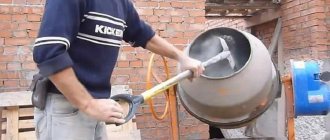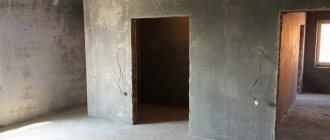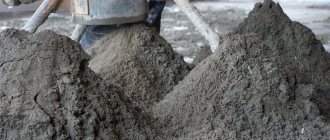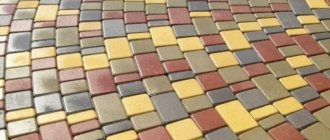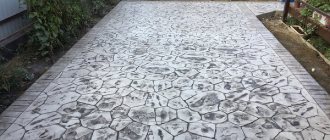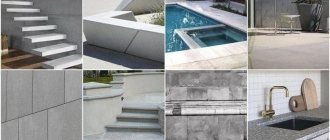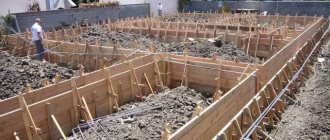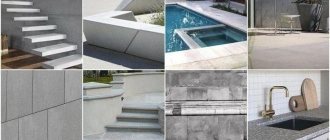When considering how to make concrete with your own hands, the proportions of the components should be taken into account first. Concrete mixture is the most important component of any construction, and the quality of the structure being built largely depends on its proper preparation. It is not always possible to buy ready-made mortar, so it is advisable for any builder to know how to prepare the material themselves. If you adhere to the recipe and mix all the elements well, the constructed foundation will reliably last for many decades.
Concrete composition
Before you start preparing the mixture, you need to understand its composition and proportions. A standard foundation grout contains the following ingredients:
- Cement
is the main component of the mixture, which affects the strength properties of concrete. It is a binder for the solution and is selected by brand taking into account the upcoming tasks. - Sand
is a fine filler that increases the strength of the structure. For preparation, use well-cleaned material, without sludge and other foreign matter. - Crushed stone
is a coarse aggregate having a fraction from 5 to 40 mm. When figuring out how to make concrete correctly, the proportions with crushed stone are selected according to the purposes of construction. - Water
is taken from the water supply. If water is taken from a reservoir, it must first be passed through filters. - Additives
- various plasticizers, fiber and other components that regulate the properties of the solution.
Useful tips
Here are some helpful tips to help you with your concrete mixing work.
- It is necessary to work with the material until it begins to set. In the warm season, at a temperature of 20 - 23 o C, concrete begins to harden approximately 1.5 - 2 hours after preparation.
- If you don’t have a ready-made container for mixing or emptying the concrete mixer, you can make one yourself. An improvised “trough” made of boards is enough. It should be taken into account that upon completion of the work the wood will most likely become unusable. Therefore, to create a container, it is better to use a material that is not a pity.
- Cement should not be stored for too long. Over time, the material loses its properties - it grips worse and begins to clump heavily. Therefore, before purchasing, you should pay attention to the date of manufacture.
- Washed sand is best suited for the job. However, it is more expensive. However, you can get it at the regular price. Sand is often extracted from bodies of water - lakes or rivers. When extracted from water, most of the foreign impurities are washed out. There is absolutely no dust in this sand. Therefore, if possible, preference should be given to him.
- After mixing, the solution must be properly compacted. This is done by compacting with a shovel or other tool. Compaction allows you to remove air bubbles from the solution and thereby make it stronger.
Suitable grade of cement
An important condition for preparing a high-quality mixture is the correct choice of cement brand. It is designated by the letter M and numbers that determine the maximum load on the total weight. In particular, when using M250 cement, after hardening, the structure will be able to withstand loads of up to 250 kg per square centimeter.
When telling how to mix concrete, it is worth noting that Portland cement is used for its preparation. The choice of a specific brand is determined by the type of facility being built. Materials of grades M200–M400 are suitable for the construction of foundations of private houses. When constructing industrial facilities, the M600 brand is used.
Components
Concrete consists of the following components:
- cement;
- sand;
- filler (crushed stone or gravel).
Let's talk about each ingredient in more detail.
Cement
Cement is the binding element of the mixture. It is he who connects all other components. Therefore, the strength of future concrete directly depends on cement.
When choosing, you should pay attention to the brand of cement. It is designated by the letter M and a number. The lowest class is M75, the highest is M800. The class determines the strength of cement, its ability to set, and some other characteristics. The higher it is, the better. But you need to understand that high-grade cement will cost more. This is critical if a large amount of work is planned.
cement
Sand
Sand fills microcavities that form between cement particles. Use coarse grain, without contamination and additional impurities. If this is not found, you can take a fine-grained one. But it’s better not to do this - the strength of the concrete will be somewhat less.
The diameter of the grains of sand should be 2 – 2.5 mm. The total proportion of dust, clay and other impurities should not exceed 3%.
When mixing homemade concrete, it is important that the sand is not wet. The fact is that, being saturated with water, it greatly changes its volume. Thus, in the case of wet sand, it will not be possible to correctly calculate the proportions.
Humidity is measured as follows:
- take 2 parts of sand, equal in volume;
- one is dried in the sun;
- hang both parts;
- subtract the mass of dry sand from the mass of wet sand, divide by the mass of wet sand, multiply by 100.
What grade of concrete is used for construction?
Like cement, concrete mixtures are classified into grades that depend on the ingredients used. To build a private house, it is enough to prepare a solution of grades from M200 to M400. More accurate indicators are selected according to the type of structure:
- For light buildings (sheds, greenhouses, etc.), grades M100 or M150 are sufficient.
- For garages or bathhouses it is better to use mixtures M150, M200.
- For a residential building, the brands M350 and M400 are considered optimal.
When selecting, it is important to take into account the composition and type of soil, expected load, and climatic features of the area.
Other options
If you understand that you will not be able to prepare the foundation for pouring the foundation of a frame house or other small structures with your own hands, then seek the help of professionals. Without racking your brains over how many components to take and how to mix them, you can buy a cube of concrete, which should be enough for a small construction project. A cube of this construction product costs from 2,400 rubles. This figure applies to the lowest grade. A medium-strength cube (M400) costs from 3,200 rubles. The most expensive and reliable brand is M600. A cube of such concrete will cost 4 thousand.
Similar articles
- Mechanized semi-dry floor screed: technology, equipment
Mechanized semi-dry floor screed is economically feasible for large volumes and simple configurations of rooms/sites. Despite the name... - Do-it-yourself shallow strip foundation - Find out more!
In private low-rise construction, shallow strip foundations are used as the most economical and, moreover, reliable construction solution. This… - Do-it-yourself pigment for concrete: coloring, colored
Modern construction technologies make it possible to avoid grayness in architecture by adding concrete pigment. Colored concrete is used in construction...
Proportions
To figure out how to properly mix concrete, you need to find out the correct proportions of the finished solution. The table below shows the ratio of components used to prepare concrete from M400 cement.
| Concrete grade | Volume of a mixture of 10 liters of cement, l | The ratio of sand and crushed stone per 1 kg of cement |
| 150 | 64 | 3,5:5,7 |
| 200 | 54 | 2,8:4,8 |
| 250 | 43 | 2,1:3,9 |
| 300 | 41 | 1,9:3,7 |
| 400 | 31 | 1,2:2,7 |
Putty mix
To do this, you should arm yourself with putty, a spatula and a small container. There is a starting and finishing putty. The first has a dense porous structure; it is applied as the first layer to the walls. And the second is the final stage in leveling the surfaces; it has a smooth structure and lies as a thin second layer on the coating.
To create a batch of one or another putty, you need (they are prepared in the same way):
- putty;
- large bowl;
- water;
- putty knife.
Manufacturing instructions:
- You need to add 1 kg of putty to a bowl and pour in about 0.5 liters of water.
- Using a spatula, stir the mixture thoroughly.
- The consistency of the composition should be thick, but so that it easily comes away from the spatula.
- The homogeneous mass must be kneaded for about 5 minutes.
Cooking features
To make a high-quality mixture, it is important to first familiarize yourself with the basic methods and rules of mixing. If the requirements are met, you can get a good solution that will have high strength characteristics.
Mixing methods
If it is necessary to prepare a small portion of concrete, the work can be done manually. For large volumes, use a concrete mixer, which allows you to bring the mass to homogeneity. In the latter case, kneading is carried out in two ways:
- Water is poured into a concrete mixer and cement is poured. After mixing, add the remaining ingredients.
- All components except water are poured into the concrete mixer. The liquid is poured after mixing the dry materials.
How to mix concrete
If we consider how to mix concrete by hand, the proportions in buckets will be the most convenient for preparing the mixture. Let's consider the ratio of some brands on the basis that a bucket will contain 10 liters of material.
| Concrete grade | Cement (50 kg bag) | Sand | Crushed stone 5–20 mm | Water |
| M200 | 1 | 6 | 14 | 4 |
| M250 | 1 | 5 | 12 | 3,5 |
| Cement mortar M100 | 1 | 15 | — | 5 |
For manual preparation, you can use any suitable container, for example, a trough. The whole process goes like this:
- Sand and cement are poured into the trough.
- Mix with a shovel until smooth.
- Add water and mix well again.
- Add crushed stone, mix and use as soon as possible.
If we are talking about preparing the mixture in a concrete mixer, mixing the components will be much easier. To begin with, cement and a little water are poured into it, then mixed. Add more liquid and stir until smooth. Water is added until the mixture becomes an emulsion. After this, sand is added, mixed, and only then fillers and additives are added.
Key points
When considering how to mix concrete, it is important to consider some preparation features, which may vary depending on the type of foundation being built:
- For strip bases, rubble is often used, which increases the strength and durability of the structure. It is especially relevant for foundations that are placed on soils with deep freezing and high groundwater levels. The finished solution is poured in layers.
- Columnar foundations are used for lightweight buildings on solid soils. Unlike a strip base, the solution is poured immediately, in one go.
- Tape-column bases are suitable for heaving and unstable soils. Here you need to take into account the thickness of the foundation. If it is from 10 to 40 cm, it is necessary to use a thicker consistency of the mixture.
If you strictly follow the recommendations, you can easily prepare concrete yourself. The main thing is to maintain proportions that will ensure the necessary degree of plasticity, strength and uniformity of the kneaded mass.
Author of the article
How do the components of concrete interact with each other?
Cement and water are two components of a special “glue”. When they are combined, a chemical reaction occurs, as a result of which crystallization of cement particles begins. If there is little water, then not all of the cement mass will react; some will remain a dusty mass. And if there is a lot, then individual particles or crystals will not adhere well to each other. During the process of water absorption, the volume of the cement mortar decreases, which leads to cracking of the cement layer after complete drying.
Mixing concrete using a cultivator
To mix dry ingredients, use a motor cultivator. The device has cutters that cope with such tasks. Several cubes are mixed in 30 minutes. If you use the device daily and for a long time, the gearbox can last a long time, but it all depends on the quality of the design.
Mixing concrete for the foundation manually
- Tools for work
- Required materials
The basis of any construction project is laid in the foundation, the main components of which are concrete mortar and reinforcement. Almost all concrete plants do not ship mortar less than 1 cubic meter. And the cost of delivering a small building mixture can be expensive. Taking into account all these factors, when building a house or renovating, many mix concrete themselves.
Having special tools available, you can prepare concrete for the foundation yourself.
It is faster, more convenient and easier to mix the concrete mixture for the foundation using a manual or electric concrete mixer. But not everyone has such a construction tool, and it’s not always possible to find one for rent. And the concrete mixture can be made at home using simple tools.
Tools for work
- large container, such as an old bathtub;
- bucket;
- shovel.
When manually mixing concrete in an old bathtub, you should know that in this container the output is approximately 0.3 cubic meters of a high-quality product.
To make concrete you will need: cement, water, sand, crushed stone.
This amount of finished mass is quite enough for repair needs and independent construction. During the time until this solution runs out, workers use the entire mixture to the end and it does not have time to harden.
Now you need to understand the components of concrete and how these proportions affect the properties of the finished mass. First, you should take a 10 liter bucket of gravel and shake it well so that all the gravel settles tightly. Now, using a liter jar, we begin to fill the bucket with gravel to the very brim with water. To completely fill a bucket with water, it took, for example, 5 liters of liquid, which means that the gravel voidage is 50%. That is, when producing a concrete mixture, 1 bucket of gravel will require half a bucket of sand, in a proportional ratio of 2:1.

